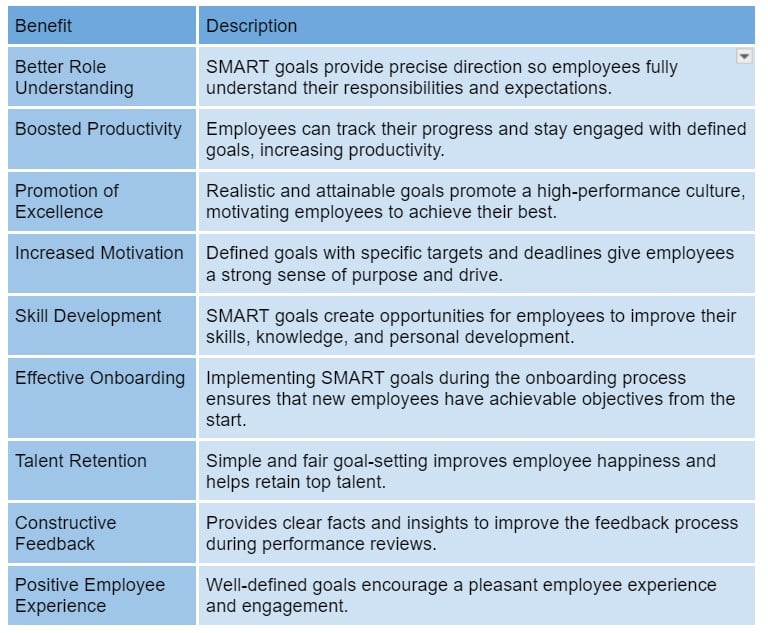Are you tired of setting goals that fizzle out faster than your New Year’s resolutions? Don’t worry, you aren’t alone! Many professionals struggle with practical goal setting.
And that is where the SMART goals come in! They guarantee that your objectives are defined and achievable. A Dominican University study proved that those who write down their goals are 42 percent more likely to achieve them.
In this article, we’ll look at the best examples of SMART performance goals for 2024 to help you improve the way you work and streamline performance assessments. Whether you want to increase productivity or improve your team’s efficiency, these SMART goals can help you succeed.
Let’s get started and make your goals a reality!
What is a SMART goal?

A SMART goal is a structured approach to goal-setting that guarantees clarity and achieveability. The term “SMART” stands for:
- Specific: Clearly state what needs to be done.
- Measurable: Establish criteria for tracking progress and measure your success.
- Achievable: Set realistic and attainable goals, given the available resources.
- Relevant: Align goals with overall corporate or personal objectives.
- Timely (Time-Bound): Set a specific deadline to maintain focus and urgency.
A SMART method is extensively used in performance evaluations and improves employee performance by defining clear and organized goals.
Implementing SMART goals for work performance can significantly improve productivity and success. This technique not only improves work performance but also guarantees that goals are realistic and timed, making them more attainable.
The benefits of setting SMART goals
Some company goals vanish faster than a morning coffee. SMART performance goals can change that. They have several advantages, from boosting output to improving employee satisfaction.
In this part, we will look at the key benefits of SMART goals and how they can improve your work environment and employee performance. Discover the main benefits and start creating effective targets straight away.

9 Examples of SMART Goals for Work
Setting SMART goals for work performance is essential for achieving specific, measurable, and realistic objectives. Here are nine SMART goals for performance review examples for increasing productivity and efficiency in diverse workplaces.
1) Management
SMART goal: “Improve team productivity by 15 percent within the next six months by implementing an innovative project management tool.”
Breakdown:
- Specific: Use a project management solution such as Asana or Trello to streamline workflows and task assignments.
- Measurable: Aim for a 15 percent increase in team productivity, tracked by project completion rates and job efficiency.
- Achievable: Organize training sessions on the new tool to ensure that all team members are capable of using it.
- Relevant: Improving team productivity is consistent with management’s responsibility to maximize performance and achieve organizational goals.
- Time-bound: Complete this productivity improvement within the next six months.
2) Finance
SMART goal: “Reduce the company’s monthly expenses by 10% over the next fiscal period by renewing supplier contracts and implementing cost-saving initiatives.”
Breakdown:
- Specific: Identify and renegotiate at least five supplier contracts.
- Measurable: Achieve a 10 percent decrease in monthly expenses, documented by monthly financial reports.
- Achievable: Use the finance team’s bargaining skills and cost analysis tools to identify savings opportunities.
- Relevant: Cutting costs is critical to increasing the company’s profitability and financial health.
- Time-bound: Complete the reduction over the following fiscal year.
Pro tip: Use invoicing software like Billdu with extensive reporting features to monitor your small business’s financial goals. This will allow you to track and analyze costs and savings accurately.
3) IT
SMART goal: “Improve cybersecurity measures by conducting quarterly security audits and reducing security incidents by 45 percent within six months.”
Breakdown:
- Specific: Perform complete security audits every quarter and immediately fix any identified vulnerabilities.
- Measurable: Aim to reduce security incidents by 45 percent using reports of breaches and monitoring technologies.
- Achievable: Use existing IT resources and employ cybersecurity professionals.
- Relevant: Strengthening cybersecurity aligns with preserving company data and maintaining business integrity.
- Time-bound: Achieve this reduction in security incidents within six months.
4) Sales
SMART goal: “Increase monthly sales revenue by 20 percent within the next nine months by expanding the client base.”
Breakdown:
- Specific: Identify and target new market segments, improve sales pitch skills, and boost follow-up efforts.
- Measurable: Monitor sales income every month to ensure a 20 percent increase.
- Achievable: Give the sales team extra training in sophisticated sales methods and customer engagement.
- Relevant: Increasing sales revenue is consistent with the company’s growth objectives.
- Time-bound: Achieve this revenue increase within the following nine months.
5) Marketing
SMART goal: “Boost website traffic by 30 percent over the next quarter through targeted digital inbound marketing campaigns.” Partnering with top digital agencies can help achieve this goal by leveraging their expertise in advanced marketing strategies and technologies.
Breakdown:
- Specific: Launch targeted social media campaigns, improve SEO, and boost content marketing initiatives.
- Measurable: Use analytics to track website traffic and aim for a 30 percent increase.
- Achievable: Allocate aside funding and resources for digital marketing activities and track progress.
- Relevant: Increasing website traffic helps marketing objectives and improves brand visibility.
- Time-bound: Achieve this traffic increase during the next quarter.
6) Human Resources
SMART goal: “Improve staff retention rates by 15 percent within the next year by improving the onboarding process, implementing a mentorship program, and utilizing cloud-based call center software to streamline communication and support for new hires.”
Breakdown:
- Specific: Create an effective onboarding program and a mentorship structure for new employees.
- Measurable: Track retention rates weekly and aim for a 15% increase.
- Achievable: Set aside funds to develop onboarding materials and train mentors.
- Relevant: Improving retention rates promotes organizational stability and lowers recruitment expenses.
- Time-bound: Achieve this improvement within the following year.
7) Customer Satisfaction
SMART goal: “Increase customer satisfaction scores by 35 percent within the next year by improving response times and enhancing customer support training.”
Breakdown:
- Specific: Set up a new customer support ticketing system and provide advanced training to support professionals.
- Measurable: Monitor client satisfaction levels through surveys.
- Achievable: Allocate resources for training and system improvements, guaranteeing that employees can effectively use new technologies.
- Relevant: Improving customer satisfaction is critical for customer retention and company reputation.
- Time-bound: Achieve this improvement during the next twelve months.
8) Research and Development
SMART goal: “Develop and prototype a new product feature that increases user engagement by 25 percent within the next eight months.”
Breakdown:
- Specific: Based on customer input, focus on developing a new feature to increase user engagement.
- Measurable: Aim for a 25 percent increase in engagement.
- Achievable: Allocate resources for development and testing.
- Relevant: Matches with company goals for increasing product value.
- Time-bound: Completed within eight months.
9) Operations
SMART goal: “Reduce the length of the production cycle by 15 percent within the next ten months by optimizing workflow processes and implementing automation tools.”
Breakdown:
- Specific: Improve workflow procedures and implement automation techniques.
- Measurable: Measure production cycle times to achieve a 15 percent reduction.
- Achievable: Set aside resources for process optimization and tool installation.
- Relevant: Align with operational efficiency and cost reduction objectives.
- Time-bound: Complete this reduction within ten months.
10 Tips for Setting Effective SMART Performance Goals
Setting SMART goals for employees could feel like juggling flaming torches. But don’t worry, it’s easier than it sounds!
Here are ten tips to help you create successful and attainable SMART goals for your team.
1) Align with Organizational Objectives
To retain relevance and strategic focus, guarantee that your goals are in line with your organization’s more significant objectives. However, they must complement the company’s overarching mission and vision.
2) Be Specific
Clearly state the objective, identifying the necessary resources, who is accountable, and what has to be accomplished. This will help to ensure that there is no room for doubt.
3) Set Measurable Criteria
Use quantitative indicators, such as goal tracking apps with targets or milestones, to measure progress and evaluate goal achievement
4) Achievability
Considering available resources and limits, ensure the aim is reasonable and attainable within the given timeframe.
5) Relevance
Choose goals that align with your role and responsibilities, enhancing your overall performance and progress.
6) Time-Bound
To stay focused and create a sense of urgency, set deadlines and don’t miss one to attain the goal.
7) Regular Reviews
Periodically review and modify goals according to progress and changing circumstances to guarantee they stay relevant and reachable.
8) Get Feedback
Request for feedback from managers and colleagues to verify that your goals are comprehensive and attainable.
9) Document Your Goals
Writing down your goals will help you track and review progress more efficiently.
10) Utilize Tools and Resources
Use project management and goal-tracking tools to keep organized while boosting goal-setting effectiveness.
Final Words
We hope these SMART goals examples will help you boost productivity, motivation, and overall success in your company. If you make sure your goals are SMART, you can plan and achieve them more successfully.
To make fast progress, start using the SMART technique to streamline your goal-setting process and generate actual outcomes.








